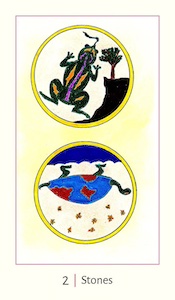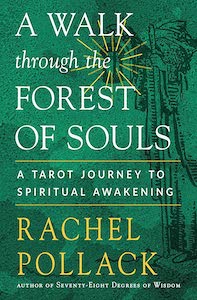
The Shining Tribe Tarot, by Rachel Pollack
Weiser Books, 9781578638178, 83 cards, 247 pages, April 2024
As a tarot enthusiast and reader for twenty years, I was excited to learn about the publication of Rachel Pollack’s revised deck The Shining Tribe Tarot. Initially published in 1992 by Aquarian Press, the deck was called The Shining Woman Tarot. In 2001 she changed some of the art on some of the cards and the deck was published by Llewellyn. The title was also changed to The Shining Tribe, which she felt better reflected the community of people drawn to tarot for divination and personal growth:
“The name was a kind of invocation, a hope that the deck would shine for others, especially in reading, and light the way for travelers on their own sacred journeys.”1
For this 2024 edition, Pollack created five new cards: one for each of the minor arcana suits and one to represent the major arcana. Although the deck was published after Pollack’s death in 2023, she was able to complete the revisions and supervise the creation of the deck before her death. It is also important to point out that Pollack created the artwork herself for all of the cards.

Rachel Pollack (1945-2023) was a giant mentor in the field of tarot. In addition to writing the bestselling book Seventy-Eight Degrees of Wisdom, she wrote the guidebooks for several tarot decks, as well as many fiction and nonfiction books. She taught at The Omega Institute for over thirty years and was a frequent panelist at tarot workshops around the world. I was blessed to meet her at a tarot workshop in Los Angeles in 2007. She was brilliant, generous, and very friendly. A group of us went to lunch during the workshop where I visited with her and Mary K. Greer!
In addition to her interest in tarot, Pollack also created the first transgender superhero in several issues of the comic book Doom Patrol. She was also known as a trailblazer within the transgender community.
“Welcome to the definitive edition of the Shining Tribe Tarot. It’s the equivalent of a director’s cut of a film. It’s the creator’s cut, Rachel Pollock’s cut. Published for the first time with all 83 color corrected cards, it also includes a full colored guidebook in which Rachel discusses the evolution of the deck, offering insights into each card and how to read them. More than merely an accompanying book, this guidebook stands as another of Rachel’s landmark Tarot guides.”2 – Judika Illes, Editor

With this Introduction, the editor opens a door into the special world of Pollack. In the next few pages, Pollack gives us a history of this deck, including the inspiration for the tribal images and artwork that she created. She talks a great deal about symbols and colors and the different cultures on which her images are based. She makes it a point to say that she wants to honor and respect the “history and living power”3 of the symbols.
The structure for this set of cards is fairly traditional, although she has adopted her own names for the suits of the minor arcana: Trees (Fire/Wands), Rivers (Water/Cups), Birds (Air/Swords), and Stones (Earth/Pentacles). She has also renamed the court cards as “Vision” cards: Place (Page), Knowers (Knight), Gifts (Queen), Speakers (King).
Pollack also shares this:
“One difference is that the Vision cards in general do not signify actual people the way the Court cards sometimes do in traditional tarot. Nor do they represent character types in quite the same way. Instead, they take us into an experience of ourselves. They give us a chance to discover and use the power of the elements.”4

The cards are a nice size, a little larger than playing cards. The card stock is a nice weight, and the matte finish is great for the ancient symbols and bright colors of the deck. Each card has a white border, and the name of the card is shown at the bottom in black type. The set comes in a beautiful box with a cut-out portion and ribbon for the cards, as well as ample room for the hefty guidebook.
These cards are easy to shuffle, and I enjoyed using them for my week of daily readings. For the first day, I drew one card: Three of Trees, which is the Three of Wands in a traditional deck. This card is always a celebration for me and I was interested to see what Pollack shares:
“This card is a celebration, filled with the laughter of the Grandfather. He welcomes and protects us with his open arms.”5
She also includes the story of the artwork, which features “a spirit image formed from a tree by the Ojibwe people of Canada.”6 The image is based on a photograph of this type of tree, which has been carved to represent a person.
The next day, I did a three-card spread and drew these cards: Knower of Birds, Six of Trees, and The Sun. With Pollack’s guidebook and my own intuition, I created this affirmation, based on the three cards:

“I collect signs and symbols and share my knowledge with confidence and wisdom, as I emerge into the light of divine consciousness.”
Her imagery is so beautiful, and the artwork invites deep contemplation and a connection to the heart. My favorite card in the deck is one of the five “extra” cards: Portrait of Albert-Bright Through Nobility, which relates to the major arcana and Spirit. Pollack explains that this card is based on the name of her animal guardian, a red fox. “The name Albert means ‘bright through nobility.’ Getting this card means a sense of protection and the ability to ask for and receive help.”7
The guidebook is very easy to navigate, from the Table of Contents to the Glossary. She includes a large section on Readings and includes lots of ideas for spreads for various situations. She also includes an Appendix which explains the name changes for all cards, how to work with reversals and how to start your own Shining Tribe. She even has notes for groups, including ways to start conversations and create activities for developing your tarot skills. The last section is a Glossary that includes references to some of the cultures, religions, and symbology used in the deck.
I really enjoy working with The Shining Tribe Tarot. I can feel the decades of tarot history, as well as the flavors of the various indigenous cultures in the cards. I can’t wait to introduce it at my next Coffee & Cards Zoom with my friends.

PJ Spur is an author, intuitive, spiritual mentor, astrologer, and hypnotist. She does tarot & oracle card readings, natal chart readings, grief coaching, and relationship healing. She also has hosted a weekly “Coffee & Cards” event with her Soul Compass Community for the past four years. Her book Navigating Grief with Grace is available on Amazon. Learn more at www.dearpj.com



